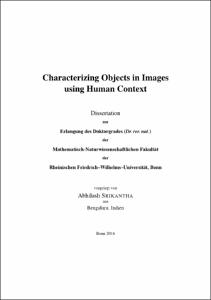Characterizing Objects in Images using Human Context

Characterizing Objects in Images using Human Context

| dc.contributor.advisor | Gall, Jürgen | |
| dc.contributor.author | Srikantha, Abhilash | |
| dc.date.accessioned | 2020-04-24T07:52:34Z | |
| dc.date.available | 2020-04-24T07:52:34Z | |
| dc.date.issued | 01.09.2017 | |
| dc.identifier.uri | https://hdl.handle.net/20.500.11811/7236 | |
| dc.description.abstract | Humans have an unmatched capability of interpreting detailed information about existent objects by just looking at an image. Particularly, they can effortlessly perform the following tasks: 1) Localizing various objects in the image and 2) Assigning functionalities to the parts of localized objects. This dissertation addresses the problem of aiding vision systems accomplish these two goals. The first part of the dissertation concerns object detection in a Hough-based framework. To this end, the independence assumption between features is addressed by grouping them in a local neighborhood. We study the complementary nature of individual and grouped features and combine them to achieve improved performance. Further, we consider the challenging case of detecting small and medium sized household objects under human-object interactions. We first evaluate appearance based star and tree models. While the tree model is slightly better, appearance based methods continue to suffer due to deficiencies caused by human interactions. To this end, we successfully incorporate automatically extracted human pose as a form of context for object detection. The second part of the dissertation addresses the tedious process of manually annotating objects to train fully supervised detectors. We observe that videos of human-object interactions with activity labels can serve as weakly annotated examples of household objects. Since such objects cannot be localized only through appearance or motion, we propose a framework that includes human centric functionality to retrieve the common object. Designed to maximize data utility by detecting multiple instances of an object per video, the framework achieves performance comparable to its fully supervised counterpart. The final part of the dissertation concerns localizing functional regions or affordances within objects by casting the problem as that of semantic image segmentation. To this end, we introduce a dataset involving human-object interactions with strong i.e. pixel level and weak i.e. clickpoint and image level affordance annotations. We propose a framework that utilizes both forms of weak labels and demonstrate that efforts for weak annotation can be further optimized using human context. | en |
| dc.language.iso | eng | |
| dc.rights | In Copyright | |
| dc.rights.uri | http://rightsstatements.org/vocab/InC/1.0/ | |
| dc.subject.ddc | 004 Informatik | |
| dc.title | Characterizing Objects in Images using Human Context | |
| dc.type | Dissertation oder Habilitation | |
| dc.publisher.name | Universitäts- und Landesbibliothek Bonn | |
| dc.publisher.location | Bonn | |
| dc.rights.accessRights | openAccess | |
| dc.identifier.urn | https://nbn-resolving.org/urn:nbn:de:hbz:5n-48028 | |
| ulbbn.pubtype | Erstveröffentlichung | |
| ulbbnediss.affiliation.name | Rheinische Friedrich-Wilhelms-Universität Bonn | |
| ulbbnediss.affiliation.location | Bonn | |
| ulbbnediss.thesis.level | Dissertation | |
| ulbbnediss.dissID | 4802 | |
| ulbbnediss.date.accepted | 16.06.2017 | |
| ulbbnediss.institute | Mathematisch-Naturwissenschaftliche Fakultät : Fachgruppe Informatik / Institut für Informatik | |
| ulbbnediss.fakultaet | Mathematisch-Naturwissenschaftliche Fakultät | |
| dc.contributor.coReferee | Leibe, Bastian |
Files in this item
This item appears in the following Collection(s)
-
E-Dissertationen (4169)




